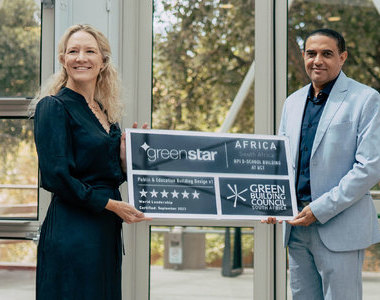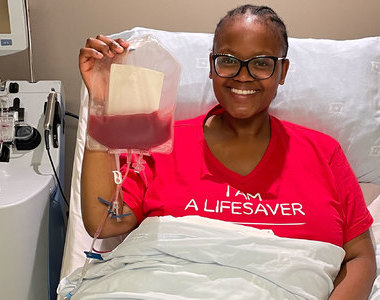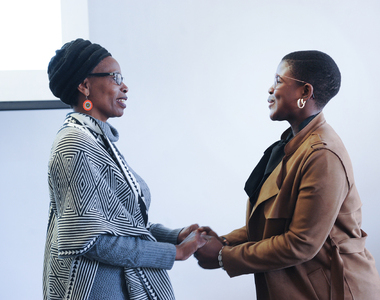The dead teach in a universal language
21 November 2019 | Story Helen Swingler. Photos Je’nine May. Read time >10 min.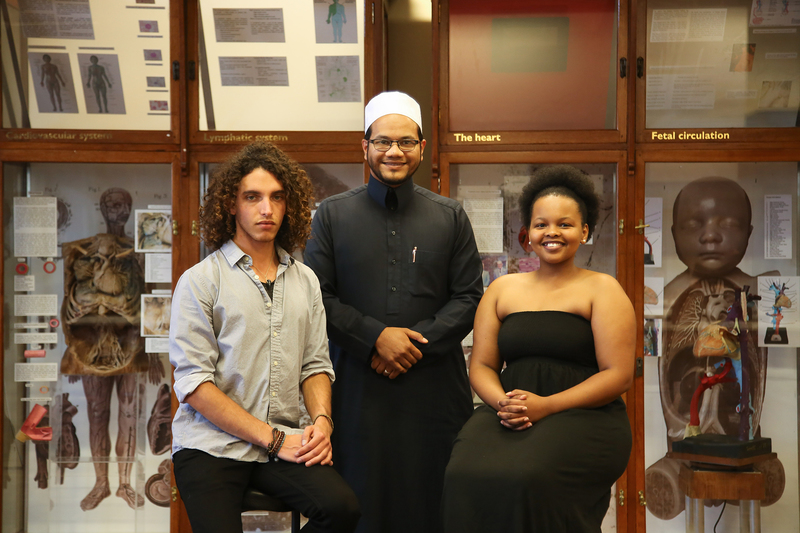
MC was not much older than Joseph Lichtman when they met. Still muscular, he’d been a powerful man once. Later, Lichtman noticed the callused ridges between his palms and fingers and the nicotine-stained fingertips. Among his tattoos were the signatures of prison life.
On closer examination, Lichtman, a second-year health sciences student at the University of Cape Town (UCT), noted the tell-tale scar from an intercostal drain between his ribs, used to remove accumulated air or fluid in the pleural cavity of the chest and often an indication of tuberculosis.
Life leaves its marks on the dead; in this case the cadavers that come to the Health Sciences faculty through UCT’s body donor programme, managed by a dedicated team and stored in the faculty’s mortuary.
But many are the unclaimed bodies of indigent people – paupers and the homeless – donated by the Department of Health. These are the silent teachers of human anatomy that await the young scholars in the dissection hall; a gift to humanity.
Dissection begins in second year, but teaching extends to postgraduates and specialists learning new clinical procedures.
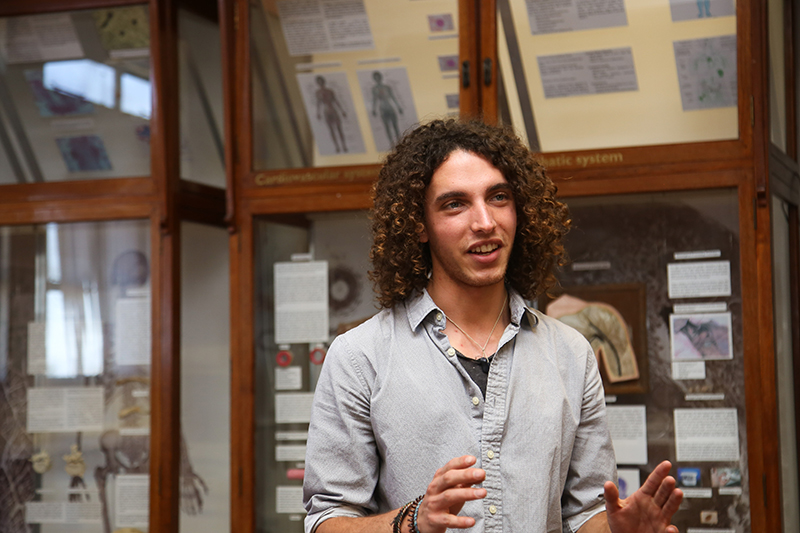
Body mapping
MC wasn’t his real name but like many of the groups, Lichtman’s group had chosen to name their cadaver to maintain the bond of humanity. To prepare them, Professor Graham Louw had given a lecture on death, dying and dissection to ease them into the dissection process. Louw has overseen the anatomy teaching programme for more than three decades and is legendary among his students.
Armed with notes and references, Lichtman said they had traced MC’s internal organs on his skin with chalk. Afterwards, nervous and over-awed, they’d played rock, paper, scissors to decide who would cut first. Their first goal was to open the body with minimal damage; students work with their cadavers for the entire academic year.
“I was terrified of the experience. I thought it might be the end of my medical career right there.”
“I was terrified of the experience,” he said. “I thought it might be the end of my medical career right there … I didn’t think I could handle the intensity.”
Though fear is a common response, for some students there are also cultural or religious taboos attached to handling the dead. Lichtman’s biggest fear was losing his humanity in the process; simply by dissociating from the man on the dissection table and seeing him as nothing more than a collection of his parts.

“It can be very jarring,” he reflected. “One moment you’re in high school, [the] next you’re given a dead person and you have to take him or her apart. We were asked to do it thoroughly, look closely and pay attention. We didn’t talk about it beforehand. It was the elephant in the room.”
A South African-born Namibian, he is the third-generation of Lichtman doctors trained at UCT. His grandfather had taught heart transplant pioneer Chris Barnard “one or two lectures”. He came to medicine by accident, literally. Out on a swimming jaunt with a friend, his friend had fallen down a tower, cracking his skull and ribs.
“All I had was a towel to stop him bleeding out,” he recalled. Fortunately, he could call on his dad, who impressed on the boy that an adventurous life was well and good, but that he’d have to know how to deal with the consequences, particularly medical emergencies.
Life in death
Through MC, Lichtman saw a lot of life. “The dead will teach you to save the living,” Louw said.
“I was reminded that these weren’t just [MC’s] organs or body parts; this had been a person suffering. I chose never to lose touch with that fact.”
As the dissection progressed, ambivalence slowly gave way to wonder. He marvelled at the smallness of the uterus (the groups swap between male and female cadavers when studying reproductive organs).
“It’s the cradle of life. We all spend the first nine months of existence in the uterus. All the formative stuff happens in the uterus and yet it’s smaller than a cell phone and appears far too simple to be such a significant thing, creating an environment that can perfectly produce a child.
“And the hands and the feet give you almost all the details of a person’s life: calluses on fingertips may show they played the guitar, or at the base of the fingers that they did hard labour. Tan lines on a finger may indicate a wedding ring. You can see heart ailments, iron deficiency, heart complications, liver problems, in finger nails.”

Death taboos
Fellow student Sinalo Nyakambi is from Matatiele in the Eastern Cape. She chose to study medicine at UCT as a way of opening her mind and challenging the sometimes parochial views of her small, closely knit home community.
“I wanted a platform to be able to bring change; a position that [the community] respects and trusts.”
Medical school was not as she expected.
“I thought we’d be clinically trained from the get-go.” But she had to wait a year before hands-on anatomical study began in the dissection hall.
“First, we watched a video interview of people who’d decided to donate their bodies, to sensitise us. I went home and thought a lot about the implications for families and loved ones. Would they have closure? I decided I could never donate my body.
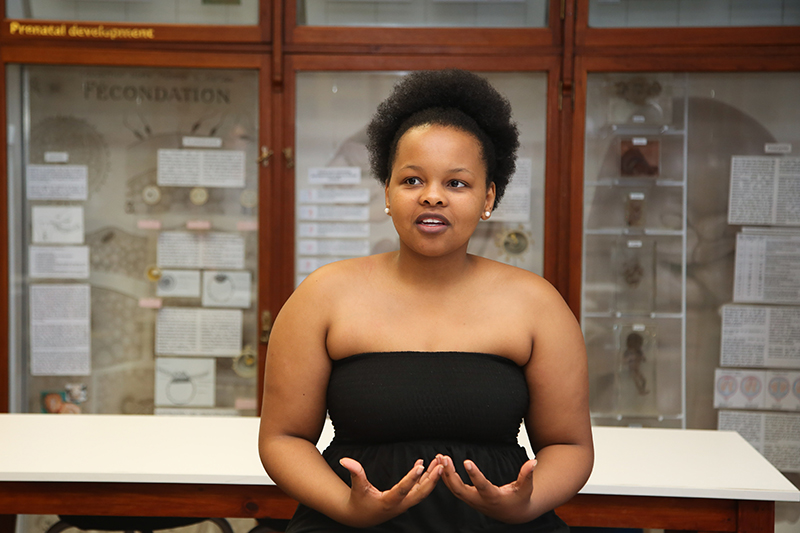
Nyakambi was part of an all-women group. Entering the dissection hall, she was faced with a “whole room full of bodies”.
“They were still covered, and I realised I was walking around so much death – and I was expected to be fine with it. I felt so emotional. I wanted to cry. But everyone around me was trying to be strong. No one wanted to be that person.
“I felt scared. I felt their spirits were there, something that tied us to them.”
It was the first time she’d encountered the dead. At community funerals she’d avoided open caskets.
“Our cadaver was an African male. I was taken aback. I hadn’t expected that. African men don’t donate their bodies … it’s not culturally acceptable. Maybe it was my coping mechanism, or my own way of dealing with stereotypes … I pulled myself together. I needed to learn; I had to get on with it.”
Later she dreamed of the cadaver – they didn’t name him – imagining him in her sleep, imagining his face, even though their faces are covered.
Heartfelt
By the second session, she had begun to relax and learn, beguiled by the complexities of the structures beneath his skin.
“When you open the chest cavity, you see the careful placing of the heart between the lungs, the lungs shaped to accommodate the heart, and the heart shaped so that it fits between the lungs, the blood vessels. Everything is so interconnected and everything runs perfectly … It’s fascinating. Beautiful.”
It was then that she realised “how profound the moment is, this act of dissection”.
His body also told a story.
“Everything is so interconnected and everything runs perfectly … It’s fascinating”
“Our cadaver had quite a few gang tattoos on his arms; it seemed he had a fungal infection on his nails, genitals and feet. He had a lot of burn marks – as if a tool was used for ritual burns.
“He was very small, perhaps malnourished. Perhaps it was due to his lifestyle. We’d constantly talk about that to make ourselves feel better about him being there and using his body.”
Had he been in a gang? Had he been a homeless person, or someone not necessarily on the right side of society? As they explored, they found an enlarged liver, indicating alcohol abuse. And his lungs were very black.
His body had quirks: only one testicle could be found – “He was probably one of those rare males who form only one” – and two instead of three main blood vessels feeding his heart.
“You see so many little miracles and you realise life itself is a miracle. We’re so intricately designed … There is so much we could not have learnt from a text book.”
Law and medicine
An imam at the Masjidur-Raoof mosque in Highlands Estate, fellow student Khalid Abduroaf had always wanted to be a doctor.
“I love solving puzzles and helping and educating people.”
Diabetes, cardiovascular disease and hypertension are rife among his community, the result of unhealthy lifestyles.
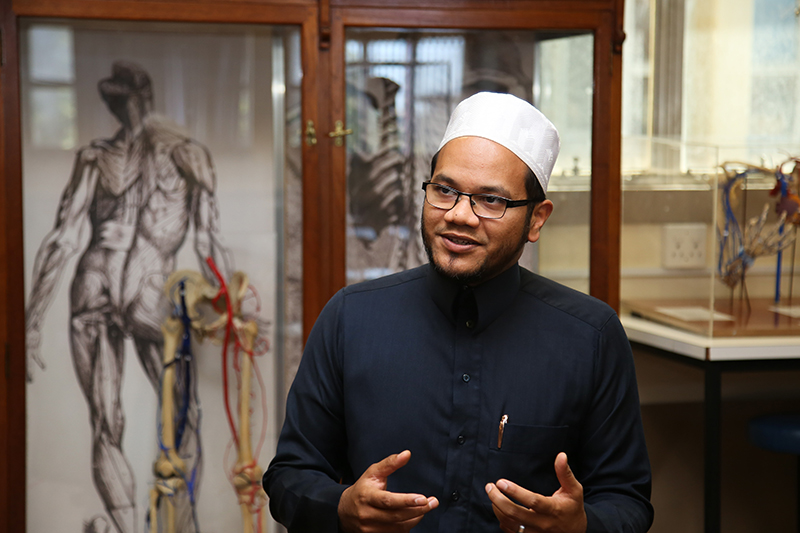
As a Muslim, he views spiritual health and physical health as partners. Instead of going straight into medicine, he wanted to uplift himself spiritually first.
“The second reason is to give back to my community. The third is that I enjoy being around people and helping them.”
During his studies in Islamic jurisprudence at the Islamic University of Madinah in Saudi Arabia, he’d encountered the giants of Islamic law and medicine through their writings. But his real interest is medical ethics in Islamic law, an area of knowledge he wants to grow locally.
“In South Africa we need individuals with both an Islamic law and medical background who are able to address these issues. I’m studying medicine to be able to bridge this gap. When it comes to practising medicine, we have to be certain that it always conforms to Islamic law.”
For example, contemporary issues like blood bank donation, artificial insemination or milk banks might not seem to be problematic. However, there are religious considerations to be followed when engaging such issues correctly, he noted.
As for dissecting cadavers, Abduroaf explains that Muslims should not dissect unless there is a need to do so, for example for the purpose of education.
“You may work on a cadaver because the benefit outweighs the harm. One body is being dissected to benefit many.”
When it came to dissection, Abduroaf drew on his Islamic background for context.
“I didn’t look at the cadaver as just a wet specimen but as a human being.”
“I understood the legal framework for cadavers and Islamic tradition. I was calm. I didn’t look at the cadaver as just a wet specimen but as a human being. We weren’t coming to something foreign but to something honourable.
“We called our cadaver Maita, which means deceased female. It’s symbolic because when we look at the deceased or someone close to us who passed on, a mother, a sister, or a daughter, we should try to show respect as we ought to with those who’ve passed away.”
It helped that the group were all Muslims. They worked in pairs, teaming up theoretical and practical skills. And they too were amazed by the complex perfection of the body’s design.
“Whenever we found something unusual or interesting, we tried to create a picture or a story. And as you are doing the dissections, their story unfolds – a lot like a CSI or a forensic exercise.
“Our cadaver was around 36 years of age. But we found mutations in her womb that indicate she may have died of cervical cancer.
“And though each cadaver has a different background – race, ethnic group, socioeconomic status – they teach us in the universal language of medicine.
“One of the things I valued a lot while working on the cadaver was understanding that no one is insignificant. It might have been an unclaimed body, but what they left behind is something you can’t comprehend – the knowledge they leave behind for others to benefit from.”
Lichtman, Nyakambi and Abduroaf participated in the faculty’s annual cadaver memorialisation ceremony in November, held to honour the cadavers and to thank their families and loved ones.
Each year second-year students remember them in word, song and dance – their gifts.
 This work is licensed under a Creative Commons Attribution-NoDerivatives 4.0 International License.
This work is licensed under a Creative Commons Attribution-NoDerivatives 4.0 International License.
Please view the republishing articles page for more information.
Listen to the news
The stories in this selection include an audio recording for your listening convenience.























































